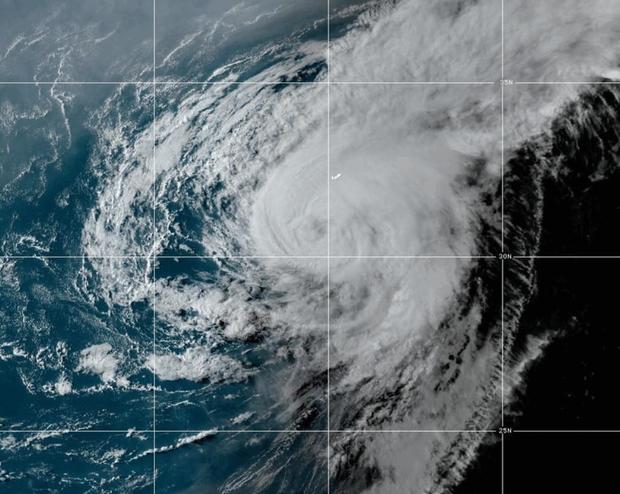
On August 18, 2024, Hurricane Ernesto made a fierce arrival in Bermuda, bringing with it powerful winds, torrential rains, and massive waves that left the island reeling. The Category 1 hurricane, although not the strongest in terms of intensity, proved that even lower-category storms can cause significant destruction, especially when they hit vulnerable, small island territories like Bermuda. The island experienced widespread power outages, flooding, and damage to infrastructure as Ernesto continued its path through the Atlantic.
Winds and Waves: A Brutal Combination
As Ernesto approached Bermuda, its winds reached speeds of up to 90 mph, strong enough to uproot trees, damage roofs, and make travel on the island nearly impossible. The storm generated enormous waves that crashed into the coastline, threatening the island’s infrastructure. Coastal roads were submerged under several feet of water, while storm surges eroded beaches and damaged sea walls, putting some of Bermuda’s most iconic locations at risk.
Reports from the Bermuda Weather Service indicated that Ernesto’s waves reached heights of 20 to 30 feet offshore, slamming into the island with a force that eroded coastlines and washed away small structures. These waves, combined with the storm surge, led to flash flooding in low-lying areas, creating hazardous conditions for residents.
Power Outages Across the Island
One of the most significant impacts of Hurricane Ernesto was the widespread loss of power across Bermuda. The Bermuda Electric Light Company (BELCO) reported that over 70% of the island’s homes and businesses were without electricity shortly after the storm made landfall. Efforts to restore power were hampered by the continuing high winds and heavy rain, making it difficult for crews to assess damage and begin repairs. The island’s government urged residents to remain indoors and avoid travel as downed power lines and debris made the roads dangerous.
Torrential Rains: Flooding Threat
While the winds and waves were already causing significant problems, Ernesto’s torrential rainfall compounded the island’s woes. The storm dumped several inches of rain within just a few hours, overwhelming drainage systems and leading to severe flooding in parts of the island. Streets in Bermuda’s capital, Hamilton, were transformed into rivers, and residents in low-lying areas were advised to evacuate to higher ground. Authorities also warned of potential landslides in hilly areas, where the saturated ground could give way under the relentless rain.
Emergency Response and Resilience
Despite the intensity of the storm, Bermuda’s government and emergency services were well-prepared, having dealt with hurricanes in the past. Shelters were opened across the island, and emergency personnel were on standby to assist residents in distress. The island’s early warning systems and preparedness plans likely saved lives, as residents had ample time to secure their homes and evacuate to safer areas if needed.
Bermuda has a long history of weathering tropical storms and hurricanes, and its buildings and infrastructure are designed to withstand strong winds. However, Ernesto’s arrival serves as a reminder of the constant threat posed by these storms, particularly as climate change leads to more frequent and intense weather events in the Atlantic.
Looking Ahead
As Hurricane Ernesto moves away from Bermuda, recovery efforts are expected to begin in full force. BELCO crews will work tirelessly to restore power, while the government focuses on cleaning up debris, assessing infrastructure damage, and providing aid to those affected by the storm. Though the island’s residents are resilient, the recovery process may take time, especially given the widespread impact of the storm.
In the wake of Hurricane Ernesto, Bermuda will continue to rebuild, just as it has done after previous hurricanes. However, this storm has once again highlighted the vulnerability of island nations to extreme weather, prompting renewed discussions about infrastructure improvements and climate resilience.
On August 18, 2024, Hurricane Ernesto made landfall in Bermuda as a Category 1 storm, bringing dangerous winds, torrential rain, and life-threatening surf conditions. Though Ernesto weakened after its landfall, the National Hurricane Center (NHC) warned that its impacts would continue to be felt, especially along the East Coast of the United States, where dangerous beach conditions could persist into the following week.
Impact on Bermuda
Ernesto battered Bermuda with sustained winds of 75 mph, causing widespread damage. Coastal flooding, storm surges, and heavy rainfall posed significant risks to the island. The NHC reported that the storm could bring up to 9 inches of rain, raising concerns of life-threatening flash flooding. Many residents took precautions, boarding up homes and preparing for the worst. Despite the storm’s weakening, its slow movement prolonged the island’s exposure to these hazardous conditions.
A tropical storm warning replaced the initial hurricane warning for Bermuda as Ernesto moved north-northeast at 6 mph, gradually pulling away from the island. However, the storm left behind considerable damage, including fallen trees, damaged homes, and flooded streets. Emergency responders were on high alert as residents dealt with power outages and disruptions to daily life.
Threat to the U.S. East Coast
Although Hurricane Ernesto is expected to remain well offshore from the U.S. mainland, the storm’s effects are being felt along the East Coast. The NHC warned that dangerous rip currents and life-threatening surf conditions would likely affect beaches from Florida to New England into early next week. These hazardous conditions could lead to dangerous swimming and boating environments, prompting beachgoers and mariners to exercise caution.
The slow-moving nature of Ernesto also means that its impact on surf conditions could last several days, increasing the risks of coastal erosion and dangerous waves. Authorities are urging residents and tourists in affected areas to stay updated on local advisories and warnings.
Ernesto’s Forecast Path
As of Saturday, Ernesto was located approximately 85 miles northeast of Bermuda, continuing its journey northward. Forecasters predict that the storm will turn northeastward by the end of the weekend and potentially brush Newfoundland, Canada, early next week. Although the storm will weaken as it moves over cooler waters, meteorologists caution that Ernesto could still bring heavy rain and strong winds to parts of Canada’s Atlantic provinces.
Hurricane Ernesto, a powerful Category 1 storm, made landfall in Bermuda on Saturday, bringing severe winds, heavy rains, and dangerous storm surges. With winds peaking at 85 mph, Ernesto left thousands without power and caused significant coastal damage. Despite the storm weakening as it moved away from Bermuda, its far-reaching impacts were felt along the U.S. East Coast, tragically resulting in two deaths.
Impact on Bermuda
Ernesto’s arrival early Saturday marked the island’s encounter with the full force of the hurricane. Western Bermuda was hit hardest, with pounding waves, intense rain, and strong winds causing widespread power outages and flooding. According to Bermuda’s utility provider BELCO, over 26,000 customers, or about 72% of the island’s residents, were without electricity by Saturday morning. Mark Sudduth, a storm tracker from FOX Weather, reported from Bermuda, describing the eerie experience of being in the eye of the hurricane. Despite the chaos, officials remained confident that Bermuda, resilient in the face of many past storms, would recover quickly.
Government authorities urged residents to remain indoors even after the eye of the storm passed, warning that the dangerous conditions persisted throughout the day. Videos and images from the scene showed waves battering the island’s shores and widespread damage to homes and infrastructure. Roads were flooded, and debris scattered across streets, adding to the challenges faced by emergency services.
U.S. East Coast Hit by Rip Currents
Even though the hurricane remained hundreds of miles offshore, the U.S. East Coast felt the storm’s effects. Powerful rip currents and dangerous surf conditions were reported along the coastlines of the Carolinas. Tragically, two deaths occurred in South Carolina due to rip currents, a reminder of the dangers these ocean conditions can pose even when a hurricane is far from land.
North Carolina’s Outer Banks also saw significant damage, with at least one home destroyed due to storm surge and rough seas. Beaches across the East Coast, particularly in the Carolinas, were closed to swimmers over the weekend as authorities warned of the heightened risk posed by Ernesto’s lingering swells. The National Hurricane Center (NHC) stressed that these dangerous conditions could last into the coming week, especially in areas popular with tourists during the summer season.
Ernesto’s Forecast Path
As of Saturday evening, Ernesto was moving slowly to the northeast, gradually weakening as it pulled away from Bermuda. The hurricane’s sustained winds decreased to 75 mph by the time it reached Bermuda, but the NHC warned that the storm could still bring significant rainfall and strong winds as it moves toward Canada.
Ernesto is forecasted to affect Newfoundland, Canada, early next week. The country’s national weather agency, Environment Canada, has issued warnings for heavy rain, moderate winds, and large ocean swells for the southern part of Newfoundland, including St. John’s. While the storm is expected to weaken further as it moves into colder waters, residents are urged to prepare for potential flooding and coastal damage.
Conclusion
Hurricane Ernesto’s landfall in Bermuda and its widespread effects highlight the power of even a Category 1 storm. With significant damage to Bermuda’s infrastructure and tragic fatalities caused by rip currents along the U.S. East Coast, Ernesto serves as a sobering reminder of the dangers hurricanes pose, both directly and indirectly. As the storm weakens and moves toward Canada, communities are bracing for more potential impacts. Coastal residents are advised to heed all warnings and remain vigilant as hurricane season continues.
